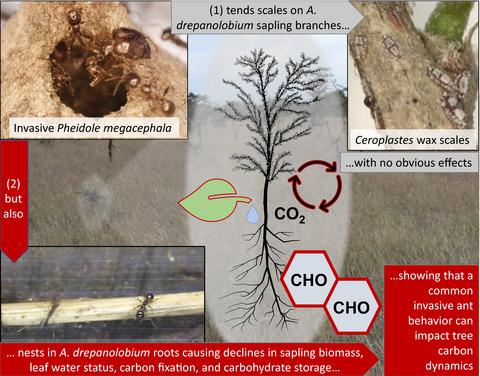Our official English website, www.x-mol.net, welcomes your feedback! (Note: you will need to create a separate account there.)
A soil-nesting invasive ant disrupts carbon dynamics in saplings of a foundational ant–plant
Journal of Ecology ( IF 5.5 ) Pub Date : 2021-11-08 , DOI: 10.1111/1365-2745.13803 Patrick D. Milligan 1, 2 , Timothy A. Martin 3 , Elizabeth G. Pringle 2, 4 , Corinna Riginos 2, 5 , Gabriella M. Mizell 2, 4 , Todd M. Palmer 1, 2
中文翻译:

土壤筑巢入侵蚂蚁破坏了基础蚂蚁植物幼苗的碳动力学
更新日期:2021-11-08
Journal of Ecology ( IF 5.5 ) Pub Date : 2021-11-08 , DOI: 10.1111/1365-2745.13803 Patrick D. Milligan 1, 2 , Timothy A. Martin 3 , Elizabeth G. Pringle 2, 4 , Corinna Riginos 2, 5 , Gabriella M. Mizell 2, 4 , Todd M. Palmer 1, 2
Affiliation

|
- Nearly every terrestrial ecosystem hosts invasive ant species, and many of those ant species construct underground nests near roots and/or tend phloem-feeding hemipterans on plants. We have a limited understanding of how these invasive ant behaviours change photosynthesis, carbohydrate availability and growth of woody plants.
- We measured photosynthesis, water relations, carbohydrate concentrations and growth for screenhouse-reared Acacia drepanolobium saplings on which we had manipulated invasive Pheidole megacephala ants and native Ceroplastes sp. hemipterans to determine whether and how soil nesting and hemipteran tending by ants affect plant carbon dynamics. In a field study, we also compared leaf counts of vertebrate herbivore-excluded and -exposed saplings in invaded and non-invaded savannas to examine how ant invasion and vertebrate herbivory are associated with differences in sapling photosynthetic crown size.
- Though hemipteran infestations are often linked to declines in plant performance, our screenhouse experiment did not find an association between hemipteran presence and differences in plant physiology. However, we did find that soil nesting by P. megacephala around screenhouse plants was associated with >58% lower whole-crown photosynthesis, >31% lower pre-dawn leaf water potential, >29% lower sucrose concentrations in woody tissues and >29% smaller leaf areas. In the field, sapling crowns were 29% smaller in invaded savannas than in non-invaded savannas, mimicking screenhouse results.
- Synthesis. We demonstrate that soil nesting near roots, a common behaviour by Pheidole megacephala and other invasive ants, can directly reduce carbon fixation and storage of Acacia drepanolobium saplings. This mechanism is distinct from the disruption of a native ant mutualism by P. megacephala, which causes similar large declines in carbon fixation for mature A. drepanolobium trees. Acacia drepanolobium already has extremely low natural rates of recruitment from the sapling to mature stage, and we infer that these negative effects of invasion on saplings potentially curtail recruitment and reduce population growth in invaded areas. Our results suggest that direct interactions between invasive ants and plant roots in other ecosystems may strongly influence plant carbon fixation and storage.
中文翻译:

土壤筑巢入侵蚂蚁破坏了基础蚂蚁植物幼苗的碳动力学
- 几乎每个陆地生态系统都有入侵的蚂蚁物种,其中许多蚂蚁物种在根部附近建造地下巢穴和/或倾向于在植物上以韧皮部为食的半翅目昆虫。我们对这些侵入性蚂蚁行为如何改变木本植物的光合作用、碳水化合物可用性和生长的了解有限。
- 我们测量了遮蔽棚饲养的Acacia drepanolobium树苗的光合作用、水关系、碳水化合物浓度和生长,我们在这些树苗上操纵了侵入性的大头蚁和原生Ceroplastes sp。半翅目昆虫以确定蚂蚁的土壤筑巢和半翅目昆虫是否以及如何影响植物碳动态。在一项实地研究中,我们还比较了入侵和未入侵稀树草原中脊椎动物草食动物排除和暴露的树苗的叶子计数,以检查蚂蚁入侵和脊椎动物草食动物如何与树苗光合冠大小的差异相关联。
- 虽然半翅目昆虫的侵扰通常与植物性能下降有关,但我们的屏风实验并未发现半翅目昆虫的存在与植物生理学差异之间存在关联。然而,我们确实发现,P. megacephala在屏风植物周围筑巢的土壤与全冠光合作用降低 >58%、黎明前叶片水势降低 >31%、木本组织中蔗糖浓度降低 >29% 和 >29 % 较小的叶面积。在野外,被入侵的稀树草原中的树苗树冠比未入侵的稀树草原小 29%,这与掩蔽室的结果相似。
- 合成。我们证明了在根部附近筑巢的土壤是Pheidole megacephala和其他入侵蚂蚁的常见行为,可以直接减少Acacia drepanolobium幼树的碳固定和储存。这种机制与P. megacephala破坏原生蚂蚁共生关系不同,后者导致成熟的A. drepanolobium树的碳固定类似的大幅下降。金合欢从树苗到成熟阶段已经具有极低的自然补充率,我们推断入侵对树苗的这些负面影响可能会减少补充并减少入侵地区的人口增长。我们的研究结果表明,入侵蚂蚁与其他生态系统中植物根系之间的直接相互作用可能会强烈影响植物的碳固定和储存。

























 京公网安备 11010802027423号
京公网安备 11010802027423号